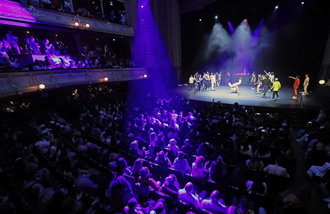Korean Beauty

Ive learned a lot from Korean culture. You only value what you have if you pay a little attention to things that you usually ignore, said Japanese housewife, Marcia Iwatate.
I didnt know Korean culture very well because I have lived in the U.S. for a long time. I rediscovered my own roots, said Korean housewife, Kim Eun-soo.
Iwatate, a restaurant consultant, and Kim (38), gallery curator, visited traditional Korean-style houses nationwide and published an illustrated magazine, Korea Style, to introduce Korean beauty. It was published by Tuttle Publishing, which has been focusing on introducing Eastern style to the West for 50 years. The book is an introduction to Korean culture, targeting the American public.
Lee Jong-keun, photographer, captured beauty from 24 traditional Korean-style houses where various people, including architects, businessmen, and designers are living, and public buildings such as Byeongsan Seowon (confucian academy) in Andong, Gong-gan building in Wonseo-dong, and Lock museum in Dongsung-dong, Jongno-gu, Seoul. He focused on Korean interiors inside the houses rather than the beauty of the architecture.
It took two years to complete the book. The three spared no effort in making the book by going so far as to clean bathrooms in the houses where they took photos and iron bedclothes.
People often think that a deep respect for all things natural, simplicity, and moderation come from Japanese culture, but they originate from Korean culture. It is very surprising to see Korean things that are both traditional and modern, and to see architecture that allows a bedroom to double as a living room and so on.
Marcia is Globalian who was born in the U.S. and has a German grandfather, Japanese father, and Korean husband. She has been recognized as a representative artist in the living design field in Japan. I can have an insight to examine culture objectively because of my blood which does not belong to any place, she says. The essence of Korean culture and lifestyle is balance, flexibility and natural beauty.
Kim went to America when she finished 7th grade and studied the history of Western art. After she came back to Korea 20 years later, she has been working as a curator in a Korean gallery for three years to introduce Western art to Korea.
Foreign artists always say, I want to get inspired by Korean culture when they visit Seoul for exhibitions. They tour museums and palaces, but there is limit. So I pleasantly accepted Marcias suggestion to publish a book, thinking that a house is a product of the living culture of a people and a country.
The philosophy of the houses shown was throwaway. It was surprising because it contradicted the more common sense of having.
No matter how much furniture costs and how pretty it is, it is of no use if it is cumbersome. We need to throw away more often, not just on the day of moving out. If we cant get rid of things, we should hide them. The most important place in the house is the area where we put things in order.
angelhuh@donga.com







